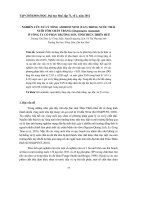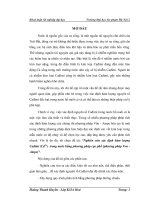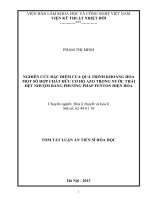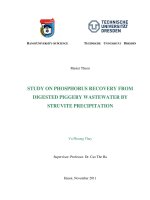Nghiên cứu xử lý thuốc diệt cỏ glyphosate trong nước bằng phương pháp fenton điện hoá
Bạn đang xem bản rút gọn của tài liệu. Xem và tải ngay bản đầy đủ của tài liệu tại đây (1.2 MB, 18 trang )
ĐẠI HỌC QUỐC GIA HÀ NỘI
TRƢỜNG ĐẠI HỌC KHOA HỌC TỰ NHIÊN
–––––––––––––––––
ĐOÀN TUẤN LINH
NGHIÊN CỨU XỬ LÝ THUỐC DIỆT CỎ
GLYPHOSATE TRONG NƢỚC
BẰNG QUÁ TRÌNH FENTON ĐIỆN HOÁ
LUẬN VĂN THẠC SỸ KHOA HỌC
Hà Nội - Năm 2015
ĐẠI HỌC QUỐC GIA HÀ NỘI
TRƢỜNG ĐẠI HỌC KHOA HỌC TỰ NHIÊN
–––––––––––––––––
ĐOÀN TUẤN LINH
TÊN ĐỀ TÀI LUẬN VĂN
NGHIÊN CỨU XỬ LÝ THUỐC DIỆT CỎ GLYPHOSATE
TRONG NƢỚC BẰNG QUÁ TRÌNH FENTON ĐIỆN HOÁ
Chuyên ngành: Kỹ thuật môi trƣờng
Mã số: 60520320
LUẬN VĂN THẠC SỸ KHOA HỌC
Ngƣời hƣớng dẫn khoa học: PGS. TS. Nguyễn Thị Hà
TS. Lê Thanh Sơn
Hà Nội - Năm 2015
LỜI CAM ĐOAN
Tôi xin cam đoan luận văn ―Nghiên cứu xử lý thuốc diệt cỏ Glyphosate trong
nước bằng phương pháp Fenton điện hoá‖ là do tôi thực hiện dƣới sự hƣớng dẫn
của PGS.TS. Nguyễn Thị Hà, Trƣờng Đại học Khoa học Tự nhiên - ĐHQGHN và
TS. Lê Thanh Sơn, Viện Công nghệ Môi trƣờng – Viện hàn lâm KHCN Viêt Nam.
Các thông tin cũng nhƣ số liệu thu thập khác đều đƣợc trích dẫn đầy đủ. Đây là
công trình nghiên cứu của riêng tôi, không trùng lặp với các công trình nghiên cứu
của các tác giả khác.
Tôi xin hoàn toàn chịu trách nhiệm về những nội dung mà tôi đã trình bày
trong Luận văn này.
Hà Nội, ngày tháng
Học viên
Đoàn Tuấn Linh
năm 2015
LỜI CẢM ƠN
Lời đầu tiên tôi xin được bày tỏ lời cảm ơn tới các Thầy, Cô giáo trường đại
học Khoa học Tự nhiên Hà Nội đã truyền đạt những kiến thức quý báu trong thời
gian học tại trường (2013 – 2015).
Để hoàn thành luận văn này, tôi xin được bày tỏ lòng biết ơn sâu sắc tới PGS.
TS. Nguyễn Thị Hà và TS. Lê Thanh Sơn đã giúp đỡ và chỉ bảo tận tình trong suốt
quá trình thực hiện luận văn.
Tôi cũng xin được bày tỏ lời cảm ơn tới Ban lãnh đạo Viện Công nghệ môi
trường - Viện Hàn lâm KHCN Việt Nam và lãnh đạo phòng Công nghệ Hoá lý môi
trường đã tiếp nhận và tạo điều kiện cho tôi thực tập tại đơn vị.
Tôi xin chân thành cám ơn nhóm thực hiện đề tài “Nghiên cứu xử lý nước ô
nhiễm hóa chất bảo vệ thực vật bằng quá trình oxy hóa điện hóa kết hợp với thiết bị
phản ứng sinh học - màng MBR” và toàn thể các đồng nghiệp đã tạo điều kiện và
giúp đỡ tôi trong suốt quá trình thực hiện luận văn.
Cuối cùng tôi xin được bày tỏ lời cảm ơn tới người thân, bạn bè và gia đình
đã động viên, giúp đỡ và tạo điều kiện cho tôi hoàn thành khoá học.
Hà Nội, ngày tháng năm 2015
Học viên
Đoàn Tuấn Linh
MỤC LỤC
DANH MỤC BẢNG
DANH MỤC HÌNH
MỞ ĐẦU .....................................................................................................................1
CHƢƠNG 1. TỔNG QUAN .......................................................................................3
1.1.Thuốc diệt cỏ Glyphosate......................................................................................3
1.1.1.Khái quát về hoá chất bảo vệ thực vật ...............................................................3
1.1.2. Cấu tạo và tính chất hoá lý ................................................................................3
1.1.3. Tình hình sử dụng .............................................................................................5
1.1.4. Ảnh hƣởng của thuốc diệt cỏ Glyphosate đến môi trƣờng và sức khoẻ con
ngƣời ...........................................................................................................................5
1.1.5. Các phƣơng pháp xử lý Glyphosate ..................................................................7
1.2. Phƣơng pháp Fenton điện hoá ..............................................................................8
1.2.1. Một số phƣơng pháp xử lý nƣớc ô nhiễm hoá chất bảo vệ thực vật .................8
1.2.2. Đặc điểm của quá trình fenton điện hoá .........................................................15
1.2.3. Ƣu nhƣợc điểm của quá trình fenton điện hoá ................................................16
1.2.4. Một số nghiên cứu áp dụng fenton điện hoá để xử lý nƣớc thải .....................17
CHƢƠNG 2: NỘI DUNG VÀ PHƢƠNG PHÁP NGHIÊN CỨU...........................19
2.1. Hoá chất và dụng cụ thí nghiệm.........................................................................19
2.2. Hệ thí nghiệm Fenton điện hoá ..........................................................................19
2.2.1. Sơ đồ hệ thiết bị thí nghiệm ............................................................................19
2.2.2. Điện cực .........................................................................................................20
2.2.3. Nguồn một chiều .............................................................................................21
2.2.4. Các nội dung nghiên cứu.................................................................................22
2.3. Các phƣơng pháp phân tích ................................................................................23
2.3.1. Phân tích TOC .................................................................................................23
2.3.2. Phân tích hàm lƣợng Glyphosate bằng phƣơng pháp đo quang .....................24
CHƢƠNG 3: KẾT QUẢ VÀ THẢO LUẬN ............................................................27
3.1. Kết quả nghiên cứu các yếu tố ảnh hƣởng đến quá trình Fenton điện hoá ........27
3.1.1. Ảnh hƣởng của pH dung dịch .........................................................................27
3.1.2. Ảnh hƣởng của nồng độ chất xúc tác ..............................................................30
3.1.3. Ảnh hƣởng của cƣờng độ dòng điện ...............................................................32
3.1.4. Ảnh hƣởng của nồng độ Glyphosate ban đầu .................................................36
3.2. Đánh giá khả năng phân hủy Glyphosate bằng quá trình Fenton điện hoá........38
KẾT LUẬN ...............................................................................................................41
TÀI LIỆU THAM KHẢO .........................................................................................43
DANH MỤC CÁC CHỮ VIẾT TẮT
AOP
Advance Oxidation Process
BVTV
Bảo vệ thực vật
POPs
Persistant Organic Pollutants
PTPƢ
Phƣơng trình phản ứng
SXNN
Sản xuất nông nghiệp
TOC
Total organic carbon
WHO
World Health Organization
DANH MỤC BẢNG
Bảng 1. Các quá trình oxy hoá tiên tiến không nhờ tác nhân ánh sáng ...................12
Bảng 2. Các quá trình oxy hoá tiên tiến nhờ tác nhân ánh sáng ..............................12
Bảng 3. Kết quả đo mật độ quang cho các dung chuẩn có nồng độ khác nhau .......25
Bảng 4. Giá trị TOC (mg/l) của dung dịch Glyphosate trong thực hiện quá trình
fenton điện hóa ở các điều kiện pH khác nhau (C0 = 10-4 mol/L, [Fe2+]= 10-4 mol/L,
I = 0,5 A, V = 0,2 L). .................................................................................................27
Bảng 5. Giá trị TOC (mg/l) của dung dịch Glyphosate trong quá trình fenton điện
hóa với các nồng độ chất xúc tác Fe2+ khác nhau(C0 = 10-4 mol/L, pH= 3, I = 0,5
A, V = 0,2 L) ..............................................................................................................30
Bảng 6. Giá trị TOC (mg/l) của dung dịch Glyphosate trong quá trình fenton điện
hóa ở các mức dòng điện khác nhau (pH=3, [Fe2+]=10-4mol/L, C0=10-4mol/L) ....33
Bảng 7. Giá trị TOC (mg/l) của dung dịch Glyphosate có nồng độ đầu khác nhau,
pH= 3 tại các thời điểm trước và sau khi thực hiện quá trình fenton điện hóa, I =
0,5A, [Fe2+] = 10-4 mol/L. .........................................................................................36
Bảng 8. Kết quả đo quang của thí nghiệm đánh giá khả năng xử lý Glyphosate
trong nước của phương pháp Fenton điện hoá.........................................................39
DANH MỤC HÌNH
Hình 1. Một số hình ảnh về thuốc bảo vệ thực vật Glyphosate ..................................4
Hình 2. Các quá trình chính tạo ra gốc OH● trong AOP .........................................11
Hình 3. Sơ đồ cơ chế tạo ra gốc OH● trong quá trình Fenton điện hóa [86 ...........16
Hình 4. Sơ đồ hệ thống thí nghiệm fenton điện hóa ..................................................20
Hình 5. Điện cực vải Cacbon ....................................................................................21
Hình 6. Điện cực lưới Platin .....................................................................................21
Hình 7. Nguồn một chiều (Programmable PFC D.C.Supply 40V/30A, VSP 4030, BK
Precision) ..................................................................................................................21
Hình 8. Hệ thống phân tích TOC ..............................................................................24
Hình 9. Đường chuẩn của phương pháp phân tích nồng độ glyphosate bằng đo
quang. ........................................................................................................................26
Hình 10. Ảnh hưởng của pH dung dịch đến giá trị TOC của dung dịch Glyphosate
trong quá trình fenton điện hóa(C0 = 10-4 mol/L, [Fe2+]= 10-4 mol/L, I = 0,5 A, V =
0,2 L). ........................................................................................................................28
Hình 11. Ảnh hưởng của pH dung dịch đến quá trình xử lý dung dịch Glyphosate
bằng Fenton điện hóa, (C0 = 10-4 mol/L, I = 0,5 A, [Fe2+] = 0,1 mM, V = 0,2 L).
...................................................................................................................................29
Hình 12. Ảnh hưởng của nồng độ Fe2+ đến hàm lượng TOC trong quá trình xử lý
dung dịch Glyphosate bằng Fenton điện hóa(C0 = 10-4 mol/L, pH= 3, I = 0,5 A, V =
0,2 L) .........................................................................................................................31
Hình 13. Ảnh hưởng của nồng độ Fe2+ đến quá trình xử lý dung dịch Glyphosate
bằng Fenton điện hóa, (C0 = 10-4 mol/L, V = 0,2 L, I = 0,5 A, pH =3) ...................31
Hình 14. Ảnh hưởng của cường độ dòng điện đến giá trị TOC của dung dịch
Glyphosate trong quá trình fenton điện hóa (C0 = 10-4 mol/L, pH = 3 Fe2+ = 10-4
mol/L, V = 0,2 L). ......................................................................................................33
Hình 15. Ảnh hưởng của cường độ dòng điện đến quá trình xử lý dung dịch
Glyphosate bằng Fenton điện hóa (C0 = 10-4 mol/L, V = 0,2 L, [Fe2+]= 0,1 mM, pH
= 3) ............................................................................................................................34
Hình 16. Ảnh hưởng của cường độ dòng điện đến quá trình xử lý dung dịch
Glyphosate bằng Fenton điện hóa, (C0 = 10-4 mol/L, V = 0,2 L, [Fe2+]= 0,1 mM,
pH = 3, t = 15 phút). .................................................................................................35
Hình 17. Điện cực vải cacbon bị hỏng ......................................................................36
Hình 18. Ảnh hưởng của nồng độ Glyphosate ban đầu đến hiệu quả khoáng hóa của
quá trình fenton điện hóa ([Fe2+] = 10-4 mol/L, I = 0,5A, V = 0,2 L, pH=3). .........37
Hình 19. Hiệu quả khoáng hóa biến thiên theo nồng độ ban đầu của
Glyphosate([Fe2+] = 10-4mol/L, I = 0,5 A; V = 0,2 L, pH = 3). ..............................37
Hình 20. Nồng độ Glyphosate còn lại trong dung dịch khi xử lý bằng quá trình
Fenton điện hoá, I = 0,5A, pH = 3, [Fe2+]= 0,1 mM, dung dịch Glyphosate C0 =
33,8 mg/L...................................................................................................................40
TÀI LIỆU THAM KHẢO
Tiếng Việt
1. Nguyễn Thị Lê Hiền, Phạm Thị Minh (2009), "Khoáng hóa metyl đỏ bằng
phƣơng pháp Fenton điện hóa", TC Hoá học, T.47(2), 207 – 212.
2. Nguyễn Thị Lê Hiền, Đinh Thị Mai Thanh (2005), "Phản ứng ôxi hóa phenol
trên điện cực cacbon pha tạp N", TC Khoa học & Công nghệ Việt Nam, T.43(2),
19-23.
3. Nguyễn Trần Oánh, Nguyễn Văn Viên, Bùi Trọng Thuỷ (2007), "Giáo trình sử
dụng thuốc bảo vệ thực vật", Trƣờng đại học Nông nghiệp Hà Nội.
4. Nguyễn Hồng Thái, Nguyễn Thị Lê Hiền (2009), "PPY (ôxit phức hợp spinel)
tổng hợp điện hóa trên graphit ứng dụng làm điện cực catot trong xử lí môi
trƣờng nhờ hiệu ứng Fenton điện hóa", TC Hóa học, T.47(1), 61 – 66.
5. Đinh Thị Mai Thanh, Nguyễn Thị Lê Hiền (2009), "Phản ứng oxi hoá phenol
trên điện cực SnO2-Sb2O5/Ti", TC Hóa học, T.47(6), 668 – 673.
Tiếng Anh
6. S. Ammar, M. A. Oturan, L. Labiadh, A. Guersalli, R. Abdelhedi, N. Oturan,
and E. Brillas (2015) "Degradation of tyrosol by a novel electro-Fenton process
using pyrite as heterogeneous source of iron catalyst", Water Research 74, 7787.
7.
.
nadón, M. R. Martínez-Larrañaga, M.
. Martínez, V. J. Castellano, M.
Martínez, M. T. Martin, M. J. Nozal, and J. L. Bernal (2009) "Toxicokinetics
of glyphosate and its metabolite aminomethyl phosphonic acid in rats",
Toxicology Letters 190, 91-95.
8. S. Aquino Neto, and A. R. de Andrade (2009) "Electrooxidation of glyphosate
herbicide at different DS ® compositions: pH, concentration and supporting
electrolyte effect", Electrochimica Acta 54, 2039-2045.
9. N. Areerachakul, S. Vigneswaran, H. H. Ngo, and J. Kandasamy
(2007)
"Granular activated carbon (GAC) adsorption-photocatalysis hybrid system in
43
the removal of herbicide from water", Separation and Purification Technology
55, 206-211.
10. B. Balci, M. A. Oturan, N. Oturan, and I. Sires (2009) "Decontamination of
aqueous glyphosate, (aminomethyl)phosphonic acid, and glufosinate solutions
by electro-fenton-like process with Mn2+ as the catalyst", Journal of
agricultural and food chemistry 57, 4888-4894.
11. C. M. benBrook (2012) "Glyphosate tolerant crops in the EU: a forecast of
impacts on herbicide use - Greenpeace International".
12. S. Benítez-Leite et al. (2009) “Malformaciones congénitas asociadas a
agrotóxicos‖ [Congenital malformations associated with toxic agricultural
chemicals]. Archivos de Pediatría del Uruguay 80 237-247
13. B. L. Bhaskara, P.Nagaraja, (2006) ―Direct sensitive spectrophotometric
determination of glyphosate by using ninhydrin as a chromogenic reagent in
formulations and environmental water samples‖. Helvetica chimica acta, 89
(11). pp. 2686-2693
14. C. Bolognesi, G. Carrasquilla, S. Volpi, K. R. Solomon, and E. J. Marshall
(2009) "Biomonitoring of genotoxic risk in agricultural workers from five
colombian regions: association to occupational exposure to glyphosate",
Journal of toxicology and environmental health. Part A 72, 986-997.
15. D. W. Brewster, J. Warren, and W. E. Hopkins
(1991) "Metabolism of
glyphosate in Sprague-Dawley rats: Tissue distribution, identification, and
quantitation of glyphosate-derived materials following a single oral dose",
Fundamental and Applied Toxicology 17, 43-51.
16. E. Brillas, I. Sires, and M. A. Oturan (2009) "Electro-Fenton process and
related electrochemical technologies based on Fenton's reaction chemistry",
Chemical reviews 109, 6570-6631.
17. G. V. Buxton;, C. L. Greenstock;, and W. P. H. a. A. B. Ross (1988) "Critical
Review of rate constants for reactions of hydrated electronsChemical Kinetic
44
Data Base for Combustion Chemistry. Part 3: Propane", The Journal of
Physical Chemistry 17, 513-886.
18. M. Diagne, N. Oturan, and M. A. Oturan (2007) "Removal of methyl parathion
from water by electrochemically generated Fenton‘s reagent", Chemosphere 66,
841-848.
19. . Dirany, I. Sirés, N. Oturan, and M. A. Oturan (2010) "Electrochemical
abatement of the antibiotic sulfamethoxazole from water", Chemosphere 81,
594-602.
20. J. S. Do, and C. P. Chen (1994) "In situ oxidative degradation of formaldehyde
with hydrogen peroxide electrogenerated on the modified graphites", Journal of
Applied Electrochemistry 24, 936-942.
21. H. Gaillard et al. (1998) ―Effect of pH on the oxidation rate of organic
compounds by Fe-II/H2O2. Mechanisms and simulation‖, New chemical. 22 (3)
263 – 268
22. W. Gebhardt, and H. F. Schröder (2007) "Liquid chromatography–(tandem)
mass spectrometry for the follow-up of the elimination of persistent
pharmaceuticals during wastewater treatment applying biological wastewater
treatment and advanced oxidation", Journal of Chromatography A 1160, 34-43.
23. S. Hammami, N. Oturan, N. Bellakhal, M. Dachraoui, and M. A. Oturan (2007)
"Oxidative degradation of direct orange 61 by electro-Fenton process using a
carbon felt electrode: Application of the experimental design methodology",
Journal of Electroanalytical Chemistry 610, 75-84.
24. M. G. Healy, M. Rodgers, and J. Mulqueen
(2007) "Treatment of dairy
wastewater using constructed wetlands and intermittent sand filters",
Bioresource Technology 98, 2268-2281.
25. M. S. Heard, C. Hawes, G. T. Champion, S. J. Clark, L. G. Firbank, A. J.
Haughton, A. M. Parish, J. N. Perry, P. Rothery, R. J. Scott, M. P. Skellern, G.
R. Squire, and M. O. Hill
(2003) "Weeds in fields with contrasting
conventional and genetically modified herbicide-tolerant crops. I. Effects on
45
abundance and diversity", Philosophical Transactions of the Royal Society B:
Biological Sciences 358, 1819-1832.
26. R. Hernandez, M. Zappi, J. Colucci, and R. Jones (2002) "Comparing the
performance of various advanced oxidation processes for treatment of acetone
contaminated water", Journal of Hazardous Materials 92, 33-50.
27. J. Hoigné (1997) "Inter-calibration of OH radical sources and water quality
parameters", Water Science and Technology 35, 1-8.
28. K. Košutić, L. Furač, L. Sipos, and B. Kunst (2005) "Removal of arsenic and
pesticides from drinking water by nanofiltration membranes", Separation and
Purification Technology 42, 137-144.
29. B. G. Kwon, D. S. Lee, N. Kang, and J. Yoon (1999) "Characteristics of pchlorophenol oxidation by Fenton's reagent", Water Research 33, 2110-2118.
30. W. K. Lafi, and Z. Al-Qodah
(2006) "Combined advanced oxidation and
biological treatment processes for the removal of pesticides from aqueous
solutions", Journal of Hazardous Materials 137, 489-497.
31. P. E. Leone, C. P. Miño, M. E. Sánchez, M.
révalo, M. J. Muñoz, T. Witte,
G. O. Carrera (2007) "Evaluation of DNA damage in an Ecuadorian population
exposed to glyphosate", Genetics and Molecular Biology 30(2), 456-460
32. S. H. Lin, and C. C. Lo (1997) "Fenton process for treatment of desizing
wastewater", Water Research 31, 2050-2056.
33. S. Liu, X.-r. Zhao, H.-y. Sun, R.-p. Li, Y.-f. Fang, and Y.-p. Huang (2013)
"The degradation of tetracycline in a photo-electro-Fenton system", Chemical
Engineering Journal 231, 441-448.
34. L. Lunar, D. Sicilia, S. Rubio, D. Pérez-Bendito, and U. Nickel
(2000)
"Degradation of photographic developers by Fenton‘s reagent: condition
optimization and kinetics for metol oxidation", Water Research 34, 1791-1802.
35. S. Maddila, P. Lavanya, and S. B. Jonnalagadda
(2015) "Degradation,
mineralization of bromoxynil pesticide by heterogeneous photocatalytic
ozonation", Journal of Industrial and Engineering Chemistry 24, 333-341.
46
36. R. Mehta, H. Brahmbhatt, N. K. Saha, and A. Bhattacharya (2015) "Removal
of substituted phenyl urea pesticides by reverse osmosis membranes:
Laboratory scale study for field water application", Desalination 358, 69-75.
37. G. Moussavi, H. Hosseini, and A. Alahabadi (2013) "The investigation of
diazinon pesticide removal from contaminated water by adsorption onto
NH4Cl-induced activated carbon", Chemical Engineering Journal 214, 172179.
38. E. Neyens, and J. Baeyens (2003) "
review of classic Fenton‘s peroxidation
as an advanced oxidation technique", Journal of Hazardous Materials 98, 3350.
39. G.E. S. Nora Benachour (2009) "Glyphosate Formulations Induce Apoptosis
and Necrosis in Human Umbilical, Embryonic, and Placental Cells", Chemical
Research in Toxicology 22, 97-105.
40. M. A. Oturan (2000) "An ecologically effective water treatment technique
using electrochemically generated hydroxyl radicals for in situ destruction of
organic pollutants: Application to herbicide 2,4-D", Journal of Applied
Electrochemistry 30, 475-482.
41. M. A. Oturan, N. Oturan, C. Lahitte, and S. Trevin (2001) "Production of
hydroxyl radicals by electrochemically assisted Fenton's reagent: Application to
the mineralization of an organic micropollutant, pentachlorophenol", Journal of
Electroanalytical Chemistry 507, 96-102.
42. M. A. Oturan, J. Peiroten, P. Chartrin, and A. J. Acher (2000) "Complete
Destruction of p-Nitrophenol in Aqueous Medium by Electro-Fenton Method",
Environmental Science & Technology 34, 3474-3479.
43. M.
. Oturan;, and J. Pínon (1992) "Polyhydroxylation of salicylic acid by
electrocheically generated OH radicals", New Journal of Chemistry 16, 705710.
44. E. Pajootan, M. Arami, and M. Rahimdokht
(2014) "Discoloration of
wastewater in a continuous electro-Fenton process using modified graphite
47
electrode with multi-walled carbon nanotubes/surfactant", Separation and
Purification Technology 130, 34-44.
45. M. Panizza, and M. A. Oturan (2011) "Degradation of Alizarin Red by electroFenton process using a graphite-felt cathode", Electrochimica Acta 56, 70847087.
46. K. V. Plakas, and A. J. Karabelas (2012) "Removal of pesticides from water by
NF and RO membranes — A review", Desalination 287, 255-265.
47. A. M. Polcaro, S. Palmas, F. Renoldi, and M. Mascia
(1999) "On the
performance of Ti/SnO2 and Ti/PbO2 anodesin electrochemical degradation of
2-chlorophenolfor wastewater treatment", Journal of Applied Electrochemistry
29, 147-151.
48. R. A. Relyea (2005) "THE IMPACT OF INSECTICIDES AND HERBICIDES
ON
THE
BIODIVERSITY
AND
PRODUCTIVITY
OF
AQUATIC
COMMUNITIES", Ecological Applications 15, 618-627.
49. R. A. Relyea (2005) "THE LETHAL IMPACT OF ROUNDUP ON AQUATIC
AND TERRESTRIAL AMPHIBIANS", Ecological Applications 15, 11181124.
50. R. Rojas, J. Morillo, J. Usero, E. Vanderlinden, and H. El Bakouri (2015)
"Adsorption study of low-cost and locally available organic substances and a
soil to remove pesticides from aqueous solutions", Journal of Hydrology 520,
461-472.
51. M. Rongwu et al. (2012), ―Environmental Science Research & Design Institute
of Zhejiang Province‖,Hangzhou 310007,China
52. D. A. S.L.Lopez, S. Benitez-Leite, R. Lajmanovich, F. Manas, G. Poletta, N.
Sanchez, M.F. Simoniello, and A.E. Carrasco (2012) "Pesticides Used in South
American GMO-Based Agriculture: A Review of Their Effects on Humans and
Animal Models", Advances in Molecular Toxicology 6, 41-75.
48
53. A. T. Shawaqfeh (2010) "Removal of Pesticides from Water Using AnaerobicAerobic Biological Treatment", Chinese Journal of Chemical Engineering 18,
672-680.
54. I. Sirés, C. rias, P. L. Cabot, F. Centellas, J. . Garrido, R. M. Rodríguez, and
E. Brillas (2007) "Degradation of clofibric acid in acidic aqueous medium by
electro-Fenton and photoelectro-Fenton", Chemosphere 66, 1660-1669.
55. I. Sires, E. Brillas, M. A. Oturan, M. A. Rodrigo, and M. Panizza (2014)
"Electrochemical advanced oxidation processes: today and tomorrow. A
review", Environmental science and pollution research international 21, 83368367.
56. M. Skoumal, C. Arias, P. L. Cabot, F. Centellas, J. A. Garrido, R. M.
Rodríguez, and E. Brillas (2008) "Mineralization of the biocide chloroxylenol
by electrochemical advanced oxidation processes", Chemosphere 71, 17181729.
57. J. Szarek, A. Siwicki, A. Andrzejewska, E. Terech-Majewska, and T.
Banaszkiewicz
(2000) "Effects of the herbicide Roundup™ on the
ultrastructural pattern of hepatocytes in carp (Cyprinus carpio)", Marine
Environmental Research 50, 263-266.
58. W.Z. Tang, C.P. Huang ―2,4-Dichlorophenol oxidation kinetics by Fenton's
reagent‖, Environ. Technol., 17 (1996), p. 1371-1378.
59. W.-P. Ting, M.-C. Lu, and Y.-H. Huang
(2009) "Kinetics of 2,6-
dimethylaniline degradation by electro-Fenton process", Journal of Hazardous
Materials 161, 1484-1490.
60. H. Vereecken (2005) "Mobility and leaching of glyphosate: a review", Pest
management science 61, 1139-1151.
61. G. M. Williams, R. Kroes, and I. C. Munro (2000) "Safety Evaluation and Risk
Assessment of the Herbicide Roundup and Its Active Ingredient, Glyphosate,
for Humans", Regulatory Toxicology and Pharmacology 31, 117-165.
49
62. A. Zhihui, Y. Peng, and L. Xiaohua (2005) "Degradation of 4-Chlorophenol by
microwave irradiation enhanced advanced oxidation processes", Chemosphere
60, 824-827.
63. L. Zhou, M. Zhou, C. Zhang, Y. Jiang, Z. Bi, and J. Yang (2013) "ElectroFenton degradation of p-nitrophenol using the anodized graphite felts",
Chemical Engineering Journal 233, 185-192.
64. M. Zhou, Q. Yu, L. Lei, and G. Barton (2007) "Electro-Fenton method for the
removal of methyl red in an efficient electrochemical system", Separation and
Purification Technology 57, 380-387.
50









